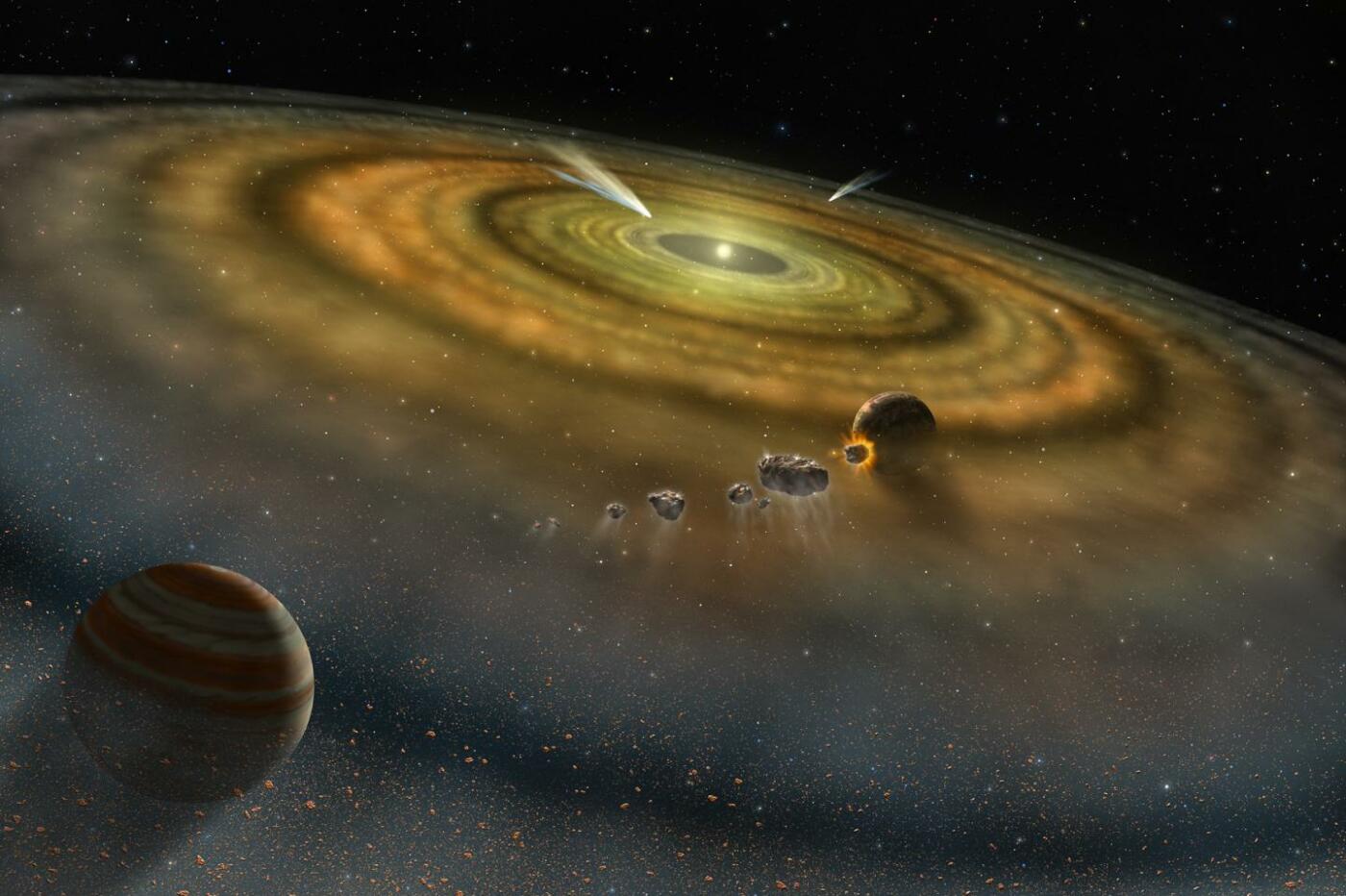Giant asteroids slammed into each other in a far-off solar system — kicking up 100,000 times more dust than the dinosaur-killing impact on Earth.
This violent deep space event occurred in Beta Pictoris, a system 63 light-years away. Beta Pictoris is known to have two gas giant planets, and is seen as a place where rocky worlds could develop. Using the powerful James Webb Space Telescope, astronomers determined that great masses of mineral dust in the system, observed with another instrument two decades ago, had largely dispersed — telltale signs of huge asteroids having collided.
“With Webb’s new data, the best explanation we have is that, in fact, we witnessed the aftermath of an infrequent, cataclysmic event between large asteroid-size bodies, marking a complete change in our understanding of this star system,” Christine Chen, an astronomer at Johns Hopkins University who led the research, said in a statement. The new planetary science was presented at the 244th Meeting of the American Astronomical Society.
Our solar system is a far older, more mature place than Beta Pictoris, without the tumult that occurs in younger systems as asteroids or larger planetary bodies often collide, and at times mass together (though collisions, of course, still happen here). Beta Pictoris is some 20 million years old, while our diverse solar system is 4.5 billion years old. Yet watching such a distant system form gives us insight into our cosmic home. Is it normal, for example, for both gas giants and smaller rocky worlds (like Earth or a super-Earth) to form in solar systems?
“We’re basically trying to understand how weird or average we are,” Kadin Worthen, an astrophysicist at Johns Hopkins University who worked on the new research, said in a statement.
“We’re basically trying to understand how weird or average we are.”
The graph below shows how a precursor to the Webb telescope, the Spitzer Space Telescope, spied huge clouds of rocky dust debris in 2004 and 2005 — evidence of two enormous collisions — but Webb could find none. The small dust minerals, finer than powder sugar, had dissipated by 2023.

The Spitzer Space Telescope detected clouds of dust in Beta Pictoris twenty years ago. It likely has since dispersed.
Credit: ROBERTO MOLAR CANDANOSA / JOHNS HOPKINS UNIVERSITY. BETA PICTORIS CONCEPT ART: LYNETTE COOK / NASA
Both the Spitzer and Webb telescopes were designed to find out how objects emit a type of light that we can’t see, called infrared. Objects in space frequently emanate this radiation, allowing Spitzer to easily detect these momentous changes in Beta Pictoris twenty years ago — while allowing Webb to now clearly see the latest cosmic environs many light-years away.
Beta Pictoris — we’re watching you.
Mashable Light Speed

An artist’s depiction of objects colliding in the distant solar system Beta Pictoris.
Credit: Johns Hopkins University
The Webb telescope’s powerful abilities
The Webb telescope — a scientific collaboration between NASA, ESA, and the Canadian Space Agency — is designed to peer into the deepest cosmos and reveal new insights about the early universe. But it’s also peering at intriguing planets in our galaxy, along with the planets and moons in our solar system.
Here’s how Webb is achieving unparalleled feats, and likely will for decades:
– Giant mirror: Webb’s mirror, which captures light, is over 21 feet across. That’s over two-and-a-half times larger than the Hubble Space Telescope’s mirror. Capturing more light allows Webb to see more distant, ancient objects. As described above, the telescope is peering at stars and galaxies that formed over 13 billion years ago, just a few hundred million years after the Big Bang.
“We’re going to see the very first stars and galaxies that ever formed,” Jean Creighton, an astronomer and the director of the Manfred Olson Planetarium at the University of Wisconsin–Milwaukee, told Mashable in 2021.
– Infrared view: Unlike Hubble, which largely views light that’s visible to us, Webb is primarily an infrared telescope, meaning it views light in the infrared spectrum. This allows us to see far more of the universe. Infrared has longer wavelengths than visible light, so the light waves more efficiently slip through cosmic clouds; the light doesn’t as often collide with and get scattered by these densely packed particles. Ultimately, Webb’s infrared eyesight can penetrate places Hubble can’t.
“It lifts the veil,” said Creighton.
– Peering into distant exoplanets: As noted above, the Webb telescope carries specialized equipment called spectrographs that will revolutionize our understanding of these far-off worlds. The instruments can decipher what molecules (such as water, carbon dioxide, and methane) exist in the atmospheres of distant exoplanets — be they gas giants or smaller rocky worlds. Webb will look at exoplanets in the Milky Way galaxy. Who knows what we’ll find?
“We might learn things we never thought about,” Mercedes López-Morales, an exoplanet researcher and astrophysicist at the Center for Astrophysics-Harvard & Smithsonian, told Mashable in 2021.
Already, astronomers have successfully found intriguing chemical reactions on a planet 700 light-years away, and as described above, the observatory has started looking at one of the most anticipated places in the cosmos: the rocky, Earth-sized planets of the TRAPPIST solar system.
Topics
NASA
